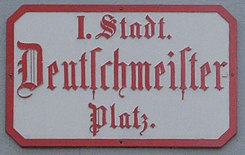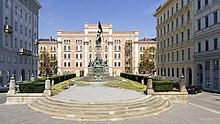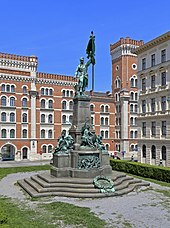Deutschmeisterplatz
| Deutschmeisterplatz | |
|---|---|
| Place in Vienna | |

|
|
| Basic data | |
| place | Vienna |
| District | Inner city |
| Created | 1876 |
| Confluent streets | Schottenring, Maria-Theresien-Strasse |
| Buildings | Deutschmeister monument |
| use | |
| User groups | Car traffic , bicycle traffic , pedestrian traffic |
| Technical specifications | |
| Square area | 1796 m² |
The German master course is on the 1st Viennese district of Inner City . It was named in 1876 after the infantry regiment Hoch- und Deutschmeister Nr. 4 , which consisted mainly of Viennese.
history
The area of today's Deutschmeisterplatz belonged to the suburb in front of the Werdertor in the Middle Ages . After the construction of the Vienna city wall , it was part of the glacis , an unspoilt area in front of it, until the 19th century . Then the wall was torn down and the Vienna Ringstrasse zone was designed in its place . In 1870, where the Deutschmeisterplatz is today, only a cross street was planned between Schottenring and Maria-Theresien-Straße, before a square was opened in front of the side of the Rossau barracks in 1876 .
Location and characteristics
Deutschmeisterplatz is a simple, rectangular square between Schottenring and Maria-Theresien-Straße, which is right in front of the gate on the side of the Rossauer barracks. The largest and middle part of the square is occupied by the Deutschmeister monument , which thus dominates the square. On both sides of the monument, two alley-like lanes remain, which are one-way streets that lead in one direction and the other. Cyclists can use the Deutschmeisterplatz in both directions, which connects the cycle paths from Schottenring and Maria-Theresien-Straße. Public transport only touches the Deutschmeisterplatz without stopping nearby. Tram line 1 runs over the Schottenring and the underground line U2 runs directly below the square. The Deutschmeisterplatz, which is located between two streets frequented by heavy traffic, has only weak local traffic and only a few pedestrians. The construction of the square consists of historicist buildings that are used for residential and office purposes and are listed buildings.
Buildings
Deutschmeister monument
→ see main article Deutschmeister monument
The Deutschmeister monument, donated in 1896, was created on the occasion of the bicentenary of the Vienna House Regiment of Hoch- and Deutschmeister No. 4. The architectural design was made by August Weber , the bronze sculptures by the sculptor Johannes Benk . The ensemble, completed in 1906, is dominant in the middle of the square and consists of a fenced-in area on a high stone plinth, in which the multi-part monument is located. The figure of a flag bearer rises on a granite obelisk, at the foot of which sits Vindobona, the allegory of the city of Vienna, on the sides the figures of the faithful comrade from 1814 on the right and the grenadier from Landshut 1809 on the left. Below the Vindobona is the bronze relief Baptism of Fire at Zenta 1697 , on the back the bust medallions of the two Grand Masters Franz Ludwig von Pfalz-Neuburg 1696 and Archduke Eugen von Österreich-Teschen 1896, as well as the coat of arms of the Teutonic Order with the bronze relief Count Soro near Kolin 1757 . In 1931 the bronze laurel wreath was added at the foot of the memorial for the victims of the First World War .
No. 1: Goldschmidt House
The building on the corner of Schottenring and Deutschmeisterplatz was built in 1879 by Wilhelm Stiassny . Between 1938 and 1945 it was the seat of the Nazi teachers' association . It has a high, square plinth above which the smooth plastered upper floors with aedicule and gable windows rise. The portal is adorned by banded Tuscan columns, above which a balcony with four caryatids can be seen. The partly old German interior of the house is particularly noteworthy.
The house is at the main address Schottenring 25.
No. 2: House Hellin and Milch
The building was erected in 1880 by Dionys Milch on the corner of Deutschmeisterplatz and Maria-Theresien-Straße. In 1953, the facade was redesigned in a simplified way with giant pilasters . The foyer and staircase are particularly noteworthy. For many years the house was the seat of the private workers' union .
No. 3: corner house
The building on the corner of Maria-Theresien-Straße and Deutschmeisterplatz was built in 1874 by Julius Dörfel . The facade consists of a high, square base zone and smooth plastered upper floors with gable windows. There are pawlats in the courtyard . The foyer is structured as a pilaster. The building is the seat of the police commissioner and city police command in the inner city as well as the police station named after the square with the entrance on Maria-Theresien-Straße.
No. 4: rental house
The building on the corner of Deutschmeisterplatz and Schottenring from 1875 was built by Rudolf Neumayr . Its original facade has been greatly reduced. Ionic pilasters can be seen on the windows and Ionic columns on the balconies.
literature
- Richard Perger: streets, towers and bastions. The road network of the Vienna City in its development and its name . Franz Deuticke, Vienna 1991, ISBN 3-7005-4628-9 , p. 35
- Felix Czeike (Ed.): Deutschmeisterplatz. In: Historisches Lexikon Wien . Volume 2, Kremayr & Scheriau, Vienna 1993, ISBN 3-218-00544-2 , p. 23 ( digitized version ).
- Bundesdenkmalamt (Ed.): Dehio-Handbuch Wien. I. District - Inner City . Verlag Berger, Horn 2003, ISBN 3-85028-366-6 , p. 663
Web links
Coordinates: 48 ° 13 ′ 1.2 ″ N , 16 ° 22 ′ 4.5 ″ E





